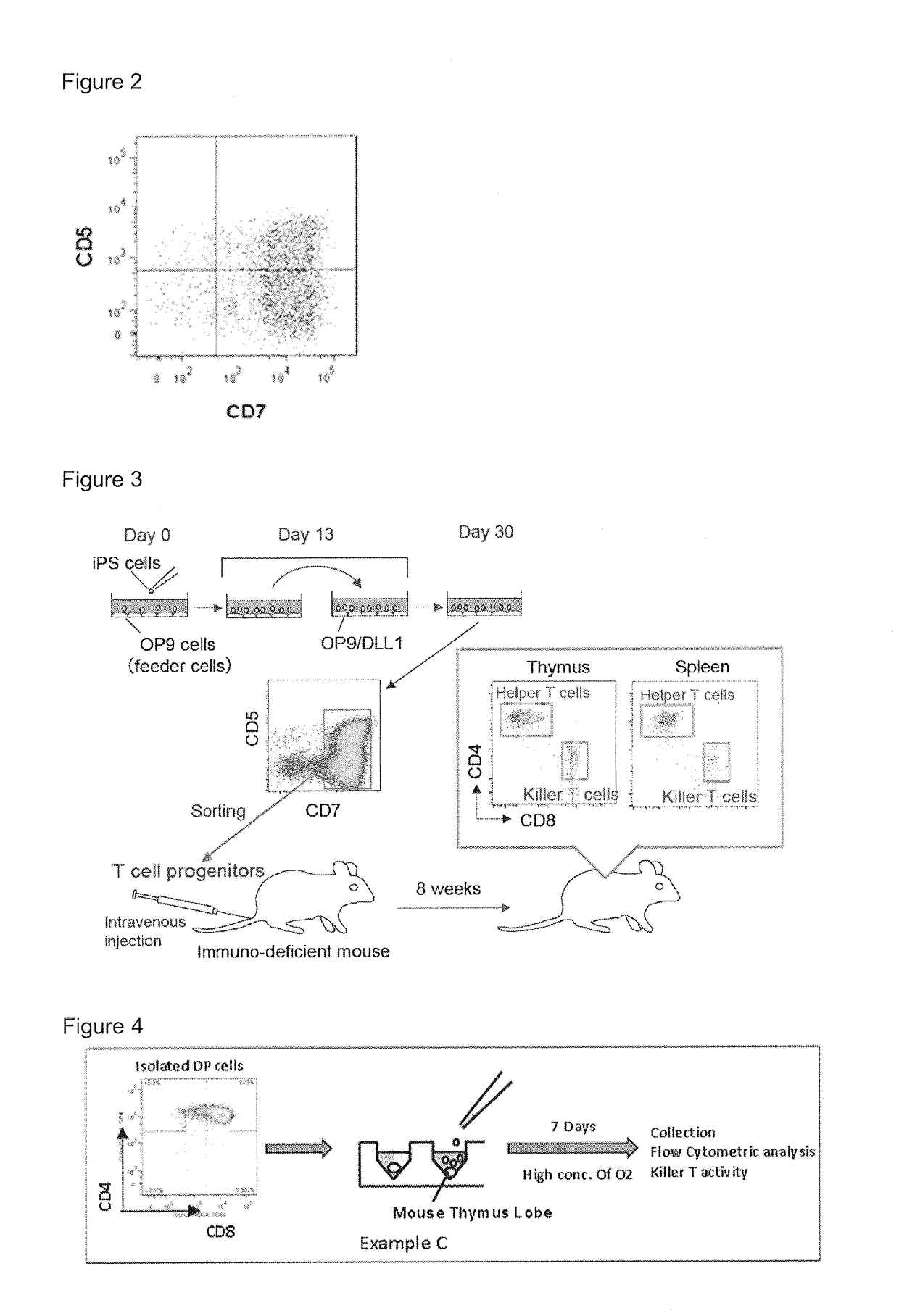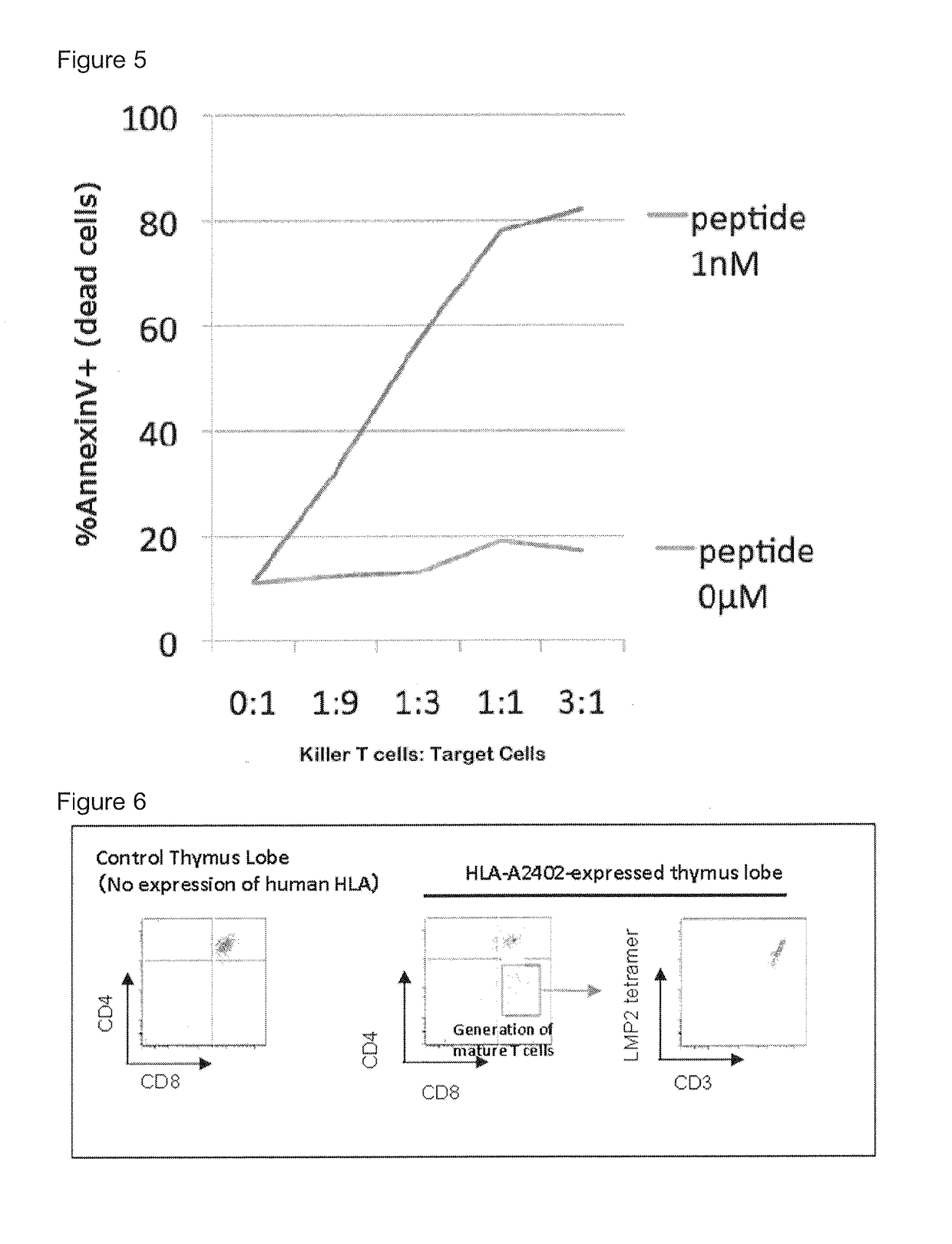Immunotherapy using t precursor cells derived from pluripotent stem cells having rearranged t cell receptor genes
a technology of pluripotent stem cells and precursor cells, applied in the field of immunotherapy, can solve the problem that the amount of t cells generated for treating one patient is fairly expensive, and achieve the effect of high quality regenerated and low cos
- Summary
- Abstract
- Description
- Claims
- Application Information
AI Technical Summary
Benefits of technology
Problems solved by technology
Method used
Image
Examples
examples
[0055]Embodiments of this application will be explained in more detail based on the examples shown below. The examples are just for illustrate and do not restrict or limit the scope of the invention disclosed herein.
example a
[0056]Induction of T Cell Progenitors from iPS Cells
Materials
[0057]OP9 cells and OP9 / DLL1 cells: obtained from Riken BioResource Center (Tsukuba, Ibaraki pref. Japan)
[0058]Human iPS cells: established from umbilical cord blood hematopoietic progenitor cells in Riken Research center for allergy and immunology (Yokohama, Kanagawa pref. Japan). The human iPS cells used herein could also be established by the method described in Vizcardo et al., Cell Stem Cell, 12:31-36, 2013.
[0059]Media used are as follows:
TABLE 1Medium A for maintenance of OP9 stromal cellscontentsamount addedfinal conc.αMEM medium500mLFCS125mL20%penicillin-streptomycin6.25mL 1%solution*Total631.25mL*Mixture of Penicillin (10,000 U / ml) and Streptomycin (10,000 μg / ml). The final concentrations were 100 U / ml and 100 μg / ml, respectively.
TABLE 2Medium B for inducing differentiation of T cells (T cell medium)contentsamount addedfinal conc.αMEM medium500mLFCS125mL20%penicillin-streptomycin5mL 1%solution*hrIL-7 (stock: 10 μg...
example b
[0081]Transplantation of T cell progenitors differentiated from iPS cells into immune deficient mice. T cell progenitors differentiated from iPS cells in Example A were transplanted into immune deficient NOG mice to show human T cells were generated. The human iPS cells were induced from CD34+ cells derived from human umbilical cord blood. The immune deficient NOG mice were purchased from Central Institute for Experimental Animals, Kawasaki city, Kanagawa, Japan.
[0082]1) Transplantation of T Cell Progenitors into Immune Deficient Mice
[0083]CD7+ T cell progenitors were isolated from the cell culture by using a cell sorter and 105 cells were intravenously injected to the recipient mice.
[0084]2) Detection of Mature T Cells in the Recipient Mice.
[0085]The mice were sacrificed at 8 weeks after the transplantation and analyzed. Mature T cells, i.e. CD4+ T cells and CD8+ T cells were observed in the thymus and spleen of the mice.
[0086]3) Negative Selection Occurred in the Recipient Mice
[00...
PUM
| Property | Measurement | Unit |
|---|---|---|
| area | aaaaa | aaaaa |
| concentrations | aaaaa | aaaaa |
| concentrations | aaaaa | aaaaa |
Abstract
Description
Claims
Application Information
 Login to View More
Login to View More - R&D
- Intellectual Property
- Life Sciences
- Materials
- Tech Scout
- Unparalleled Data Quality
- Higher Quality Content
- 60% Fewer Hallucinations
Browse by: Latest US Patents, China's latest patents, Technical Efficacy Thesaurus, Application Domain, Technology Topic, Popular Technical Reports.
© 2025 PatSnap. All rights reserved.Legal|Privacy policy|Modern Slavery Act Transparency Statement|Sitemap|About US| Contact US: help@patsnap.com



